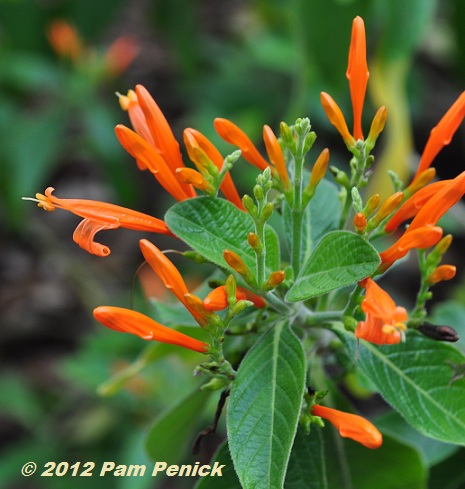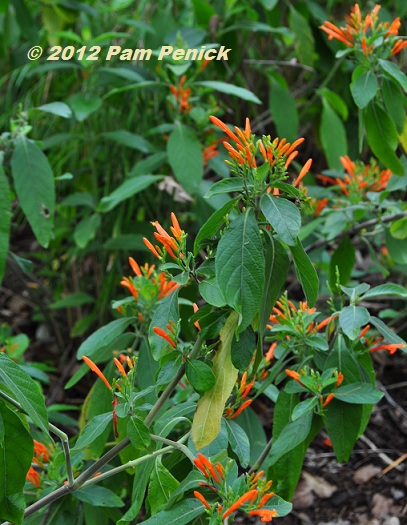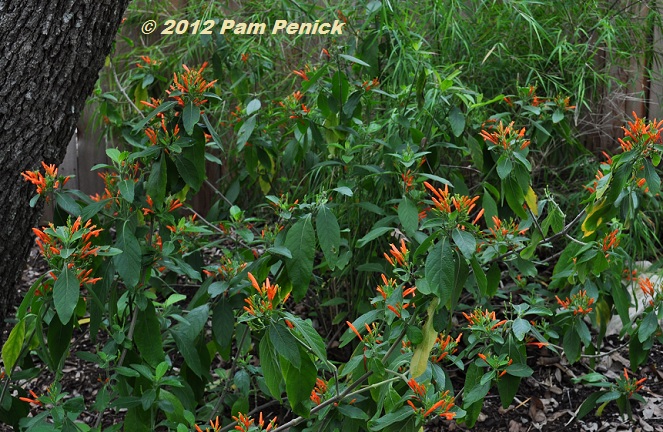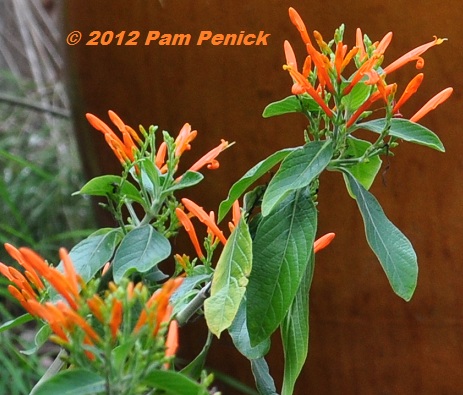Plant This: Mexican honeysuckle
Like February 29, Mexican honeysuckle (Justicia spicigera) seems an infrequent presence in Austin gardens, even though it puts on a particularly fine show at the very beginning of spring, when other plants are just yawning and stretching and sniffing the air for breakfast. Although its orange, tubular blossoms look more suited to summer or fall than spring, I’m happy to see them, especially in the dappled shade of my live oaks where little else blooms.
This is the best show I’ve seen in the two or three years since I planted them, due, no doubt, to the relief of our mild and rainy winter after a difficult last summer. They will continue to bloom off and on all summer and fall on sprawling, 3-to-4-foot willowy branches, asking little in return but partial or dappled shade and an occasional deep watering.
Mexican honeysuckle is, as its common name indicates, not native to central Texas but to Mexico and Central America. In our climate it may suffer some freeze damage or die back in particularly hard winters, but mine survived with little damage the severe freezes we experienced in early 2011. I’ve paired it with another slightly zone-pushing south-of-the-border native, Mexican weeping bamboo (Otatea acuminata aztecorum).
When the hummingbirds arrive in mid-March, on their northward migration, they’ll be happy to find the Mexican honeysuckle in bloom. Wouldn’t you?

By the way, my blog Digging is a finalist for Best Gardening Blog in the Readers’ Choice Awards at About.com. I’d love to have your vote. You can vote once a day (it’s on a 24-hour cycle) until March 21. So vote early and often! Thanks for your support! (And thank you to Pamela Price for the vote graphic.) Click to VOTE.
Note: My Plant This posts are written primarily for gardeners in central Texas. The plants I recommend are ones I’ve grown myself and have direct experience with. I wish I could provide more information about how these plants might perform in other parts of the country, but gardening knowledge is local. Consider checking your local online gardening forums to see if a particular plant might work in your region.
All material © 2006-2012 by Pam Penick for Digging. Unauthorized reproduction prohibited.






Gorgeous. Why don’t I have some?
This plant definitely benefits from shade. It peters out in direct sun here in Phoenix. We are the acid test.
I like this plant a lot. I planted one last fall and it has been blooming nicely for a few weeks now in mostly shade, especially interesting since the sun hasn’t even been out most mornings. I’ll have more shady places to plant soon and will add it there too.
I’ve had this plant on my wish list for a couple of months. Although I haven’t been able to confirm that it is native here in the Rio Grande Valley of Texas, it should do well here. It should be a great nectar source for hummingbirds, so I plan to add it to my wildscape soon.
I grew this plant and loved it! Unfortunately, I lost it during the hard freeze last winter. I should definitely get another one.
Yep, I would love to find Mexican Honeysuckle anytime. Our native honeysuckle is orange too. It has had one bloom on it most of the winter it has been so mild here.
Perfect! I have just the dappled shady spot, and was wondering this morning (as I strolled the backyard with my coffee) what I could put in that had height, color, and hardiness. As always, you and Digging provide inspiration at the perfect time.
My pleasure, Katzien. I hope it performs well for you! Mine took a couple of years to really get going. —Pam
That is a beautiful plant, Pam! I wish we could grow it here, but the second best thing is to see lovely photos of it on your blog!
Okay – so back in August I had a conference down in San Antonio. Since the conference ended at noon on Friday, and my friend and I didn’t feel like driving back to Austin right away, we decided to do the other missions that are on the Mission Trail. At one of them (and I don’t remember now, which one), a docent gave a tour. Whilst on the tour, there was a plant that I saw that I liked – it had orange blooms like the Mexican Honeysuckle (or like Firebush), and the leaves were kinda fuzzy. I bothered to actually ask about the plant, was told the name and of course have now forgotten what it was. BOO.
I’ve been pondering but don’t have any guesses, Katina. Maybe S.A. blogger Shirley at Oak-Rock-Deer would know? —Pam
Hi Pam, I just found your Blog and I’m enjoying going through all of your older posts. Wonderful!
Thanks for such inspiring posts!
-Susan
Thanks for visiting and for your kind comment, Susan! —Pam
Pam, perhaps Katina saw Dicliptera? I have one, and when I bought it they called it Mexican Honeysuckle. But it has orange blooms and fuzzy leaves and blooms a little later in the year. http://www.missouribotanicalgarden.org/gardens-gardening/your-garden/plant-finder/plant-details/kc/w340/dicliptera-suberecta.aspx
Thanks for the suggestion, Robin. I’ll pass it along to Katina. —Pam
Does this plant stop growing? We moved into a new house and just had to remove some that was growing in a corner of our yard because it has grown over into two of our neighbors yards. It is glorious…but…showing no slowing down of growth. We cut it back severely, hoping to be able to manage it within our fence line and to get it out of our neighbors yards. I hope I didn’t kill it. I am hoping to keep it pruned to a manageable size (within our fence lines), is that a reasonable assumption? I am new to gardening/landscaping.
I have not known Mexican honeysuckle to be particularly aggressive, but I’m sure a mature plant alongside a fence would willingly expand past a fence line; plants care nothing for fences, after all, unless it’s to clamber up them. Keeping it pruned up top isn’t likely to keep its roots from spreading to the neighbors’, however. Instead, you might try root-pruning it along the fence; making a narrow trench to sever any creeping roots. And if your neighbors have any sense, they’ll delight in the appearance of a free, beautiful plant in their own yards. —Pam